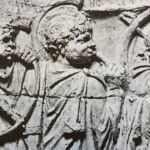Cornu, also known as the “horn of legions”, is one of the most characteristic musical instruments of ancient Rome. Its sound resounded on battlefields, during triumphal processions and in the theatre, symbolizing the power and discipline of the Roman legions. This large, curved horn made of bronze served not only a musical but also a communicative function.
Cornu was shaped like an elongated arch, about 3 meters long, with a wide mouthpiece and a bell at the end. Its shape resembled the letter “G”, which made it easier to wear on the shoulder. The musician, known as cornicen, blew into the mouthpiece, producing loud and deep tones. Interestingly, these horns often had an additional support to help support the weight of the instrument.
The Cornu played a key role in the Roman army, where it was used to transmit signals to soldiers. Various sounds informed about manoeuvres such as attacking, retreating or forming a formation. This instrument was also used during military ceremonies, providing them with an appropriate sound setting. For this reason, the cornu was often considered a symbol of Rome’s military power.
Preserved Roman reliefs, including Trajan’s Column, depict legionaries from cornu, which indicates its importance in Roman culture. Although the instrument disappeared over time, its legacy survives in the form of later wind instruments such as medieval military horns and signals.







